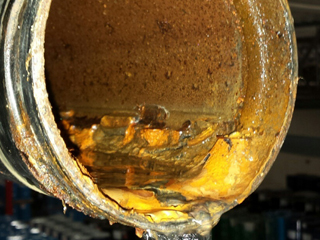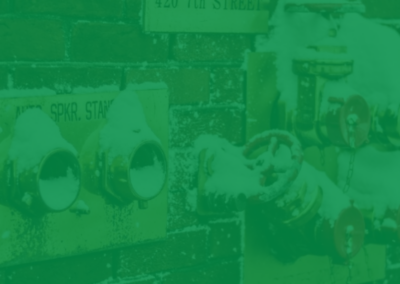Corrosion in a sprinkler system leads to pin-hole leaks and costly service calls. While a repair can patch the immediate problem, this is only a short term fix, and repairs have a tendency to disrupt the workplace. Repairing leaks and replacing pipe does not have to be a common activity for maintaining a fire sprinkler system.
 If corrosion is a factor in your system, chances are oxygen is to blame. When oxygen dissolves in the water of fire sprinkler system piping, a chemical reaction occurs that leads to corrosion. Because the cause of corrosion is frequently attributed to microbiologically-influenced corrosion (MIC), many fire protection companies tend to focus their efforts on controlling bacteria found within systems. While MIC does occur, it’s almost always a secondary and far less active type of corrosion.
If corrosion is a factor in your system, chances are oxygen is to blame. When oxygen dissolves in the water of fire sprinkler system piping, a chemical reaction occurs that leads to corrosion. Because the cause of corrosion is frequently attributed to microbiologically-influenced corrosion (MIC), many fire protection companies tend to focus their efforts on controlling bacteria found within systems. While MIC does occur, it’s almost always a secondary and far less active type of corrosion.
Instead, the most effective way to handle corrosion of a fire sprinkler system is to remove the oxygen in it. This will eliminate the solids created through the dissolved oxygen-pipe reaction that promotes the growth of bacteria.
Decreasing the oxygen in your fire sprinkler system—wet or dry—and replacing it with nitrogen is a proven method for preventing corrosion in system piping. Oxygen combines easily with water to produce solids that corrode piping, but nitrogen hardly combines with anything. Because it does not react with water or metal, it is the ideal gas to circulate in your sprinkler system. Plus, using nitrogen to remove corrosive oxygen saves 75-90% of the replacement cost for a new sprinkler system. Investing in a nitrogen system ultimately saves time, money, and headaches.
Nitrogen Systems
Oxygen is only corrosive when it is dissolved in water, because it reacts with the metal and causes rust. Nitrogen, on the other hand, does not react to metal or to water. Raising the level of nitrogen in your system’s piping will also reduce the amount of oxygen in the water. With lowered dissolved oxygen rates, oxygen is no longer able to corrode the piping. And without the solids created from the dissolved oxygen, the growth of bacteria is drastically slowed, lowering the risk of microbiologically influenced corrosion as well. This method is effective on both wet and dry pipe systems.
There are several different types of nitrogen systems – some specifically for dry and pre-action sprinkler systems and some specifically for wet sprinkler systems. Dry and pre-action systems are typically fed by a nitrogen generator while wet systems are often fed through the inerting process using portable nitrogen cylinders. Generators come in several different makes, offering varying capacities and other features including an unlimited supply of on-demand nitrogen. Features of all generators include:
- The ability to be retrofitted for older systems
- The removal of oxygen in both black steel and galvanized steel piping systems
Air Vents
An air vent is a way to relieve oxygen from your system. There are different types of vents including manual and automatic. Benefits of air vents include:
- Corrosion reduction through oxygen removal from the sprinkler system
- Simple and reliable mechanical design
- Automatically closing vent when water has reached the device
Corrosion Monitoring
Corrosion monitoring equipment is a way to determine if corrosion is occurring in your system. Monitoring equipment is designed specifically to alert you should corrosion begin to form in your sprinkler system piping. Benefits include:
- Automatic notification once corrosion occurs
- Detection in both wet and dry pipe systems
- Installed at locations where corrosion tends to be worst and most common
- Easy installation
If you have questions about corrosion in your sprinkler system or wish to learn more about solutions for corrosion, please contact Ryan Fireprotection.

